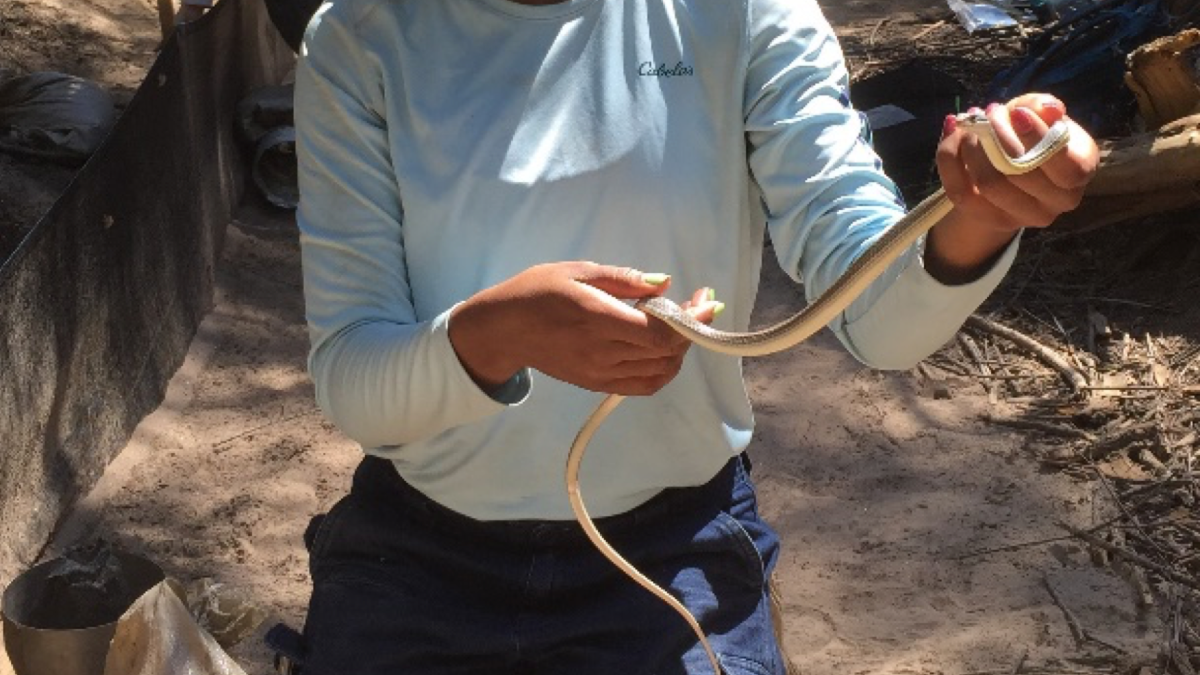ASU military vet answers call of the wild

Applied biological sciences graduating senior Lauren Nicole Jackson had a summer internship experience after her junior year, doing research in the San Pedro River Preserve, that cemented her decision to focus her studies and career on wildlife ecology.
Editor’s note: This is part of a series of profiles for spring 2017 commencement. See more graduates here.
After serving five years with the U.S. Army in military intelligence at Fort Hood, Texas, and then working with the Army a few more years in California as a civilian contractor, Lauren Nicole Jackson moved back to Arizona to attend Arizona State University.
Jackson, who grew up Glendale, Arizona, started out at ASU’s Downtown Phoenix campus as a pre-med student, living in the residence hall.
“I decided it would be good to live in the dorms my first year while I adjusted to a different lifestyle and made new friends. But the more classes I took, the more I realized I like working with animals more than people,” explained Jackson, who said she has always had a love for animals.
She changed her major to applied biological sciences in the College of Integrative Sciences and Arts, and so for the last several years has commuted from Phoenix, where she lives, out to ASU’s Polytechnic campus in Mesa. In May she graduates with a bachelor of science with a concentration in applied ecology and pre-veterinary medicine as well as a certificate in wildlife management.
Last summer, as a junior, Jackson held a pivotal internship with ASU wildlife ecologist Professor Heather Bateman, conducting an undergraduate research project on lizard species at the San Pedro River Preserve, in Pinal County. This summer she will continue collecting data for the study.
“My focus was pre-vet when I started the internship, and by the end of the summer I had changed to applied ecology and added the certificate in wildlife management,” said Jackson.
“My research project is looking at the mite loads in two different species of Whiptail lizard (Teiidae). I am comparing mite loads between Aspidoscelis sonorae, an all-female species that reproduces parthenogenically with eggs that are clones of the mother, and Aspidoscelis tigris, a species that reproduces sexually,” she said. “I am also comparing mite loads across three different habitats: Tamarix, Prosopis and Populus.”
Bateman explained the significance of studying these particular lizards.
“Since there’s no genetic variety in the A. sonorae populations, we’re looking at whether or not the species is more susceptible to certain diseases,” said Bateman. “One way to look at how well off these parthenogenic species are in terms of health and disease is to evaluate external mites.”
Jackson has found that A. tigris had a smaller mite load compared with that of A. sonorae, but the A. tigris also had a smaller mite load in non-native habitat.
“This supports my hypothesis that native habitat would have a higher mite load because of the lack of coevolution,” observed Jackson. “Since the Tamarix is an invasive species, the mites and whiptails did not coevolve in that habitat.”
Her future data collection will take in place in the Tamarix habitat to provide more data for comparison, and she’ll be working toward getting the research published.
“I have presented the research poster twice now,” Jackson said, “including at the Wildlife Society Meeting JAM (Joint Annual Meeting of the Arizona/New Mexico American Fisheries Society and the Arizona and New Mexico chapters of The Wildlife Society) in February.”
Jackson shared with ASU Now these additional reflections about her ASU experience.
Q: What was your “aha” moment, when you realized you wanted to study what you’re studying?
A: When I started my internship last summer on the San Pedro River Preserve, although I was extremely excited, I had some reservations about what I would be doing. It was new, and I had never handled a lizard in my life. But slowly, I started to notice how much I would miss work when I wasn’t working, and no matter how tired, sleepy, hungry or dirty I got, there wasn’t anything else I would rather be doing.
Q: Why did you choose ASU?
A: I grew up in Phoenix. Of course, I had to come here.
Q: What’s something you learned while studying at ASU that surprised you, that changed your perspective?
A: I realized that once you find something that you truly love, it becomes all that you ever do, and that’s OK. Embrace it, stay focused and you will succeed.
Q: Did you have any favorite spots to study or spend time on campus?
A: Nothing beats a good study room, and the study rooms on the Downtown Phoenix campus are my favorite. Being on that campus will always feel a little nostalgic to me.
Q: What are your plans after graduation?
A: I will be returning to my internship this summer, doing wildlife research at the San Pedro River Reserve. After that, I hope to either get a federal wildlife biologist tech position or a biology tech position in Hawaii.
Q: If someone gave you $40 million to solve one problem on our planet, what would you tackle?
A: I would use a lot of the money to fund various research grants dealing with wildlife. I would create a research grant or scholarship for undergraduate students, to get more students and the public involved in wildlife research. Getting people educated and involved is key in my field.
More Science and technology

ASU professor honored with prestigious award for being a cybersecurity trailblazer
At first, he thought it was a drill.On Sept. 11, 2001, Gail-Joon Ahn sat in a conference room in Fort Meade, Maryland.…

Training stellar students to secure semiconductors
In the wetlands of King’s Bay, Georgia, the sail of a nuclear-powered Trident II Submarine laden with sophisticated computer…

ASU startup Crystal Sonic wins Natcast pitch competition
Crystal Sonic, an Arizona State University startup, won first place and $25,000 at the 2024 Natcast Startup Pitch Competition at…